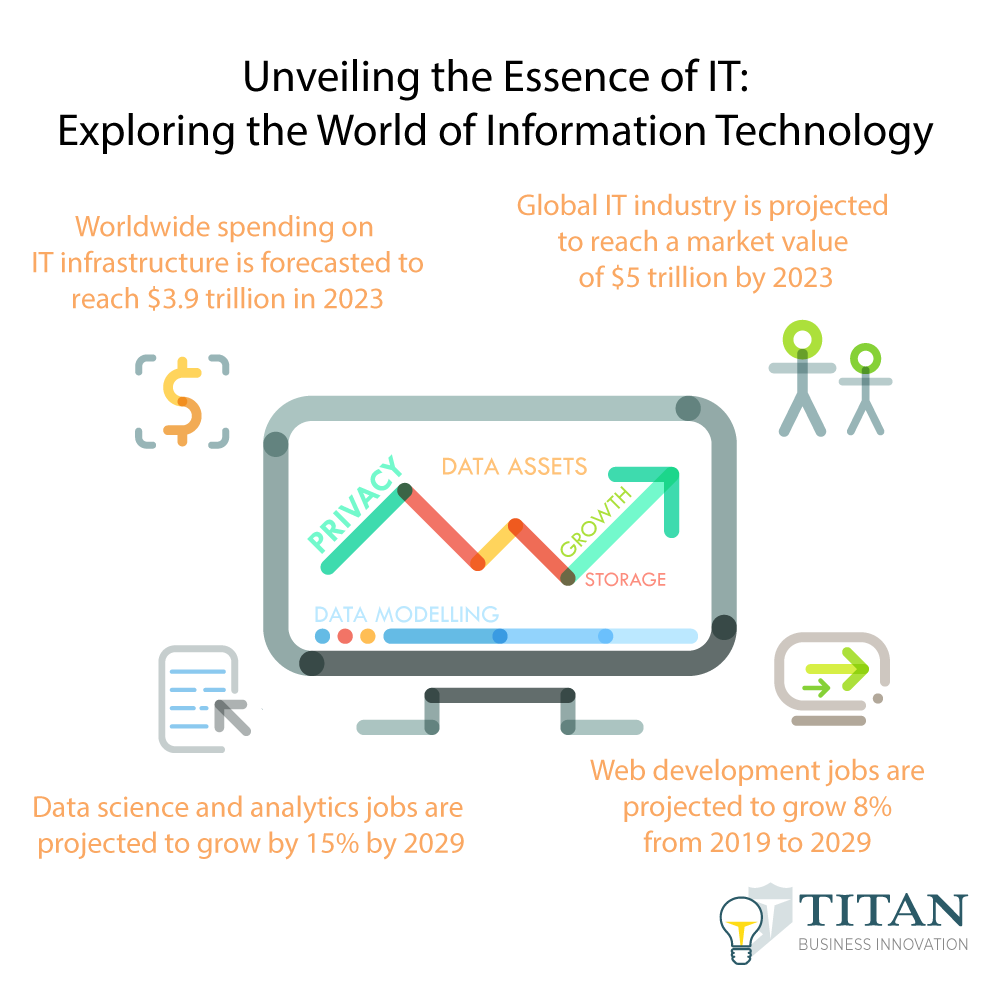
Understanding IT: Beyond Translation
IT, short for Information Technology, poses a translation challenge due to its complex nature. Nonetheless, its literal translation as “information technology” captures its essence. At its core, IT encompasses all computer and internet-related aspects, shaping our digital world. The global IT industry is projected to reach a market value of $5 trillion by 2023, reflecting its exponential growth and significance. (Source: Statista)
Diverse Professions within IT
IT encompasses various job roles, attracting professionals from multiple domains. System engineers, programmers, and consultants are among the most renowned IT professions. These individuals possess expertise in different areas, contributing to the dynamic and ever-evolving field of IT.
The demand for software developers is expected to grow by 22% between 2019 and 2029- much faster than the average for all occupations. (Source: U.S. Bureau of Labor Statistics)
Data science and analytics jobs are projected to grow by 15% by 2029, indicating the increasing need for skilled data professionals. (Source: World Economic Forum)
Renowned companies like Google, Yahoo, and Apple have become synonymous with IT. Google’s creation of the search engine, Yahoo’s establishment as a leading portal site, and Apple’s innovations in iPhones and Macs have indelibly shaped our modern way of life. These companies serve as beacons in the IT industry, constantly pushing the boundaries of technological advancement.
Decoding Web-Related Work
Within the realm of web-related work, several specialized roles contribute to the development and maintenance of websites. First, web designers creatively craft visually appealing and functional websites. Web programmers play a pivotal role in constructing website systems, with a particular emphasis on smartphone app development. Finally, web directors guide designers and coders, ensuring the seamless creation of websites while maintaining effective communication with clients. Web development jobs are projected to grow 8% from 2019 to 2029, fuelled by the increasing demand for websites and web applications. (Source: U.S. Bureau of Labor Statistics)
Understanding IT Infrastructure
IT infrastructure forms the foundation of an organization’s IT system. It encompasses physical components such as PCs, servers, and routers and non-physical elements like operating systems. Safeguarding data and protecting against security threats like leakage and virus infiltration are critical aspects of IT infrastructure management, fostering a secure and efficient IT environment.
Worldwide spending on IT infrastructure is forecasted to reach $3.9 trillion in 2023, reflecting organizations’ focus on building and maintaining robust IT environments. (Source: International Data Corporation). Cybersecurity spending is projected to exceed $200 billion annually by 2024, emphasizing the growing importance of protecting IT infrastructure from data breaches and cyber threats. (Source: Cybersecurity Ventures)
The Journey of IT Infrastructure Construction and Operation
Constructing and operating IT infrastructure follows a systematic process. It begins with requirements definition, where system specifications and objectives are determined through close collaboration between development teams and stakeholders. The subsequent stages involve development, testing, and operation, each crucial for ensuring the robustness and functionality of the IT infrastructure.

Computer programming specialist working on desktop computer and composing web code while carrying out task from order in office
The Rise of Data Analysts and Data Scientists
With the advent of Big Data, the demand for data analysts and data scientists has surged. Data scientists have broader roles encompassing various aspects of data analysis, utilizing techniques like machine learning. On the other hand, data analysts specialize in analyzing and reporting data, leveraging statistical methods rather than machine learning. Both roles play a crucial part in harnessing the power of data for business insights.
Rakuten’s Emphasis on Data Analysts
Rakuten’s focus on hiring many data analysts reflects the growing importance of data-driven decision-making in business. By employing professionals with expertise in data analysis and reporting, Rakuten aims to leverage the potential of data to drive innovation and achieve business objectives.
The Power and Potential of Data
Data has emerged as a valuable resource with transformative potential. Its utilization allows businesses to gain insights, make informed decisions, and improve processes. In an increasingly data-centric world, organizations strive to harness the power of data to gain a competitive edge and drive innovation.
Differentiating Digital Transformation (DX) and Digitization
“DX” and “digitization” are often used interchangeably, yet they possess distinct meanings. DX, or digital transformation, refers to digitalization to revolutionize business operations and enhance the working environment. In contrast, digitization focuses on replacing existing systems with digital technology to improve efficiency.
The Essence of DX and Digitization
While digitization emphasizes technological implementation, DX goes beyond that by leveraging the benefits of digitalization to generate new business opportunities and revenue streams. DX entails a comprehensive approach that incorporates the advantages of digitization into innovative initiatives, resulting in a holistic transformation of the organization.
IT, an enigmatic acronym, encompasses the vast landscape of information technology. From its diverse job roles to the construction of robust IT infrastructure and the rise of data analysts and scientists, the world of IT is ever-expanding and evolving. As we embrace digital transformation and harness the power of data, IT continues to shape our lives, driving innovation, efficiency, and connectivity in the modern era.

